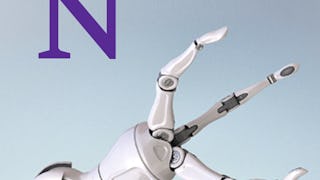Robotics Basic is an introductory course that provides a structured, hands-on overview of industrial robotics. Over 13 compact modules, learners explore the mechanical, electrical, and digital components that make up modern robotic systems.



Basics of Robotics

Instructor: Siemens Digital Industries Software
1,773 already enrolled
Included with
(11 reviews)
Skills you'll gain
- Performance Testing
- Safety Standards
- Mechanical Design
- Manufacturing Standards
- Programming Principles
- Engineering
- Safety and Security
- Computer Programming
- Control Systems
- Manufacturing and Production
- Product Automation
- Industrial Engineering
- Automation Engineering
- Automation
- Human Factors
- Robotic Process Automation
- Machine Controls
- Human Machine Interfaces
- Equipment Design
Details to know

Add to your LinkedIn profile
August 2025
4 assignments
See how employees at top companies are mastering in-demand skills

There are 4 modules in this course
This introductory module provides a comprehensive foundation for understanding the essential structure and role of industrial robots. Learners begin by exploring the definition and basic characteristics of robots, including the core components of robotic systems and how these systems support automation in modern production environments. They will then be introduced to the various types of robotic systems and their integration into industrial workflows. Emphasis is placed on component structures, functional capabilities, and safety considerations of entire robotic systems. Finally, the module addresses the classification of robots based on structural and functional criteria and explores typical application areas. Participants will learn to distinguish between conventional industrial robots and lightweight robots, understand their use cases, and reflect on how robotics is shaping today’s manufacturing and logistics industries.
What's included
5 readings1 assignment3 plugins
This module dives deeper into the technical and functional properties that define the performance of modern robotic systems. It begins with robot kinematics, where learners will explore serial and parallel structures, degrees of freedom, and coordinate systems. This provides the basis for understanding how robots move and operate in space. In the following unit on human-robot collaboration, learners will study different modes of interaction, including cooperation, coexistence, and full collaboration—with a focus on safety, technical requirements, and ethical considerations. The module then turns to performance-related criteria, starting with accuracy and repeatability, including common causes of deviation and the importance of calibration. In the units on drive systems and end effectors, participants examine mechanical design, gear types, motor systems, and the selection of grippers or tools based on the task at hand. The module concludes with position measurement technologies (absolute vs. incremental) and motion control strategies such as point-to-point, continuous path, and circular interpolation. Together, these elements form the core of robot system performance and usability in real-world environments.
What's included
7 readings1 assignment7 plugins
The third module focuses on the regulatory and safety-related dimensions of industrial robotics. It begins with an overview of programming strategies, including online methods (e.g., teach-in, master-slave) and offline programming (e.g., simulation, text-based). Learners will understand when to apply which approach and what tools are commonly used—such as the TIA Portal. The next unit addresses the legal and normative framework. Key elements include the EU Machinery Directive, ISO/TS 15066 for collaborative robots, and the structure of A-, B-, and C-level safety standards. Central to this is the five-step process of conducting a proper risk assessment for robotic systems. The final unit translates these concepts into practical safety implementations: learners identify zones within a robot cell (hazard, safe, and collaborative), explore safety components such as light curtains and emergency stops, and understand the role of operating modes and system interlocks. This practical view ensures that learners are well prepared to handle safety compliance in real-world installations.
What's included
3 readings1 assignment3 plugins
This introductory module provides a comprehensive foundation for understanding the essential structure and role of industrial robots. Learners begin by exploring the definition and basic characteristics of robots, including the core components of robotic systems and how these systems support automation in modern production environments. They will then be introduced to the various types of robotic systems and their integration into industrial workflows. Emphasis is placed on component structures, functional capabilities, and safety considerations of entire robotic systems. Finally, the module addresses the classification of robots based on structural and functional criteria and explores typical application areas. Participants will learn to distinguish between conventional industrial robots and lightweight robots, understand their use cases, and reflect on how robotics is shaping today’s manufacturing and logistics industries.
What's included
2 readings1 assignment
Instructor

Offered by
Explore more from Electrical Engineering
 Status: Free Trial
Status: Free Trial Status: Free Trial
Status: Free TrialNorthwestern University
 Status: Free Trial
Status: Free TrialL&T EduTech
 Status: Preview
Status: PreviewUniversità di Napoli Federico II
Why people choose Coursera for their career





Open new doors with Coursera Plus
Unlimited access to 10,000+ world-class courses, hands-on projects, and job-ready certificate programs - all included in your subscription
Advance your career with an online degree
Earn a degree from world-class universities - 100% online
Join over 3,400 global companies that choose Coursera for Business
Upskill your employees to excel in the digital economy
Frequently asked questions
To access the course materials, assignments and to earn a Certificate, you will need to purchase the Certificate experience when you enroll in a course. You can try a Free Trial instead, or apply for Financial Aid. The course may offer 'Full Course, No Certificate' instead. This option lets you see all course materials, submit required assessments, and get a final grade. This also means that you will not be able to purchase a Certificate experience.
When you purchase a Certificate you get access to all course materials, including graded assignments. Upon completing the course, your electronic Certificate will be added to your Accomplishments page - from there, you can print your Certificate or add it to your LinkedIn profile.
Yes. In select learning programs, you can apply for financial aid or a scholarship if you can’t afford the enrollment fee. If fin aid or scholarship is available for your learning program selection, you’ll find a link to apply on the description page.
More questions
Financial aid available,

